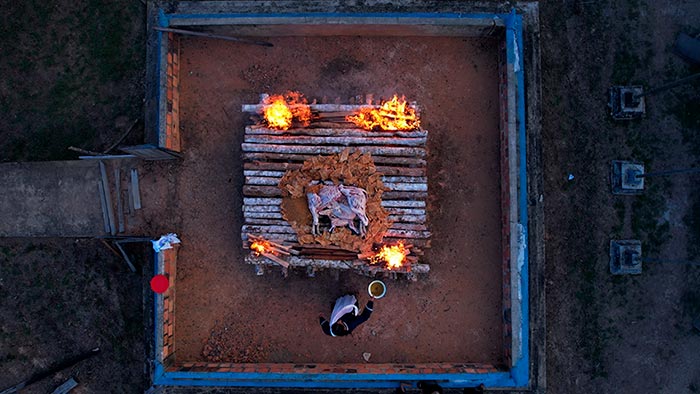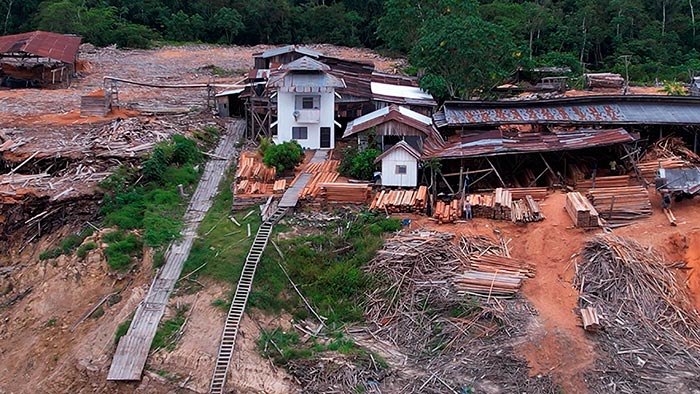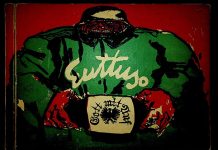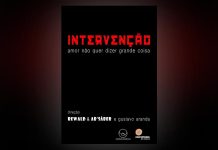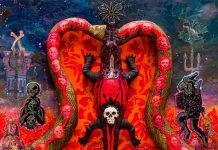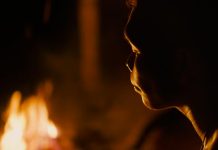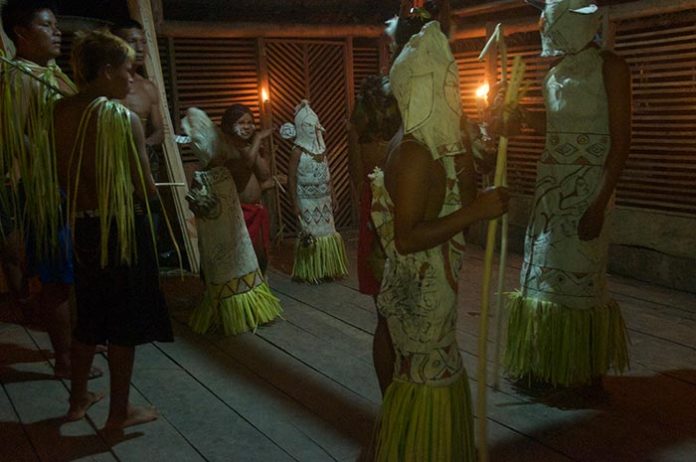
It is very difficult to leave impassive after a screening of the film O Avesso do Céu, by the duo Dias & Riedweg, showing at the galeria Vermelho until May 11th. It portrays the violence of religious manipulation in the Tikuna indigenous territory, in the Alto Solimões and Javari region, on the border of Brazil with Peru and Colombia, in real scenes, which mix rituals with images of deforestation in the Amazon, making it impossible not to notice the intrinsic link between the two.
The duo, formed 30 years ago by Brazilian Maurício Dias and Swiss Walter Riedweg, is known for working with specific communities, whether building doormen, police officers, street children or inmates of psychiatric clinics, in a rare example of emotional involvement in the panorama of Brazilian art. This new work, completed in 2023, however, is built again in a three-month immersion with two groups: indigenous and evangelicals, but in the latter without the usual empathy.
Therefore, I decided to send two questions to Maurício, who was in São Paulo for the opening, which were answered in a series of 13 audios transcribed below. The questions were: what led them to produce a work in Atalaia do Norte; and how the involvement that you generally dedicate to your work came about. Read the answers below:
***
Maurício Dias – What took us to Atalaia do Norte was the idea of doing work on Jerusalem syndrome. It actually emerged in 2013, from the residency invited by Benjamin Seroussi at the Jerusalem Visual Arts Center, in Israel.
We stayed in Jerusalem for a while. And what impressed us most there was the “crazy devotion”. I call it crazy because it is actually this heightened veneration, exhibited by hundreds of pilgrims every time they encounter the almost mythological references and monuments of their religions. This happens among Jews, Christians and Muslims. In this region there is the Al-Aqsa mosque, from where Muhammad supposedly transformed into a winged horse and went to the heavens, there is the extinct and destroyed Temple of Solomon, where Jews pray at the Western Wall, and all this next to the Holy Sepulcher , where Jesus is supposedly buried and where hundreds of Catholic and evangelical pilgrims make the Via Dolorosa, that path to the Cross, repeating the stations until Calvary. And several believers thus enter a trance, which is called Jerusalem Syndrome. This is such a recurring thing that the State of Israel didn't know what to do, because it disrupted local life, as these psychotic trances sometimes become violent. Therefore, they ended up creating [in 1951] a clinic to treat this, called Kfar Shaul, built in an old Palestinian village.
***
This Jerusalem syndrome is something that we have been trying to address in our work since 2013. We have been doing a series of work with psychiatric patients, and in these works, in these immersions that we do with a group of patients from IPUB, the Institute of Psychiatry at UFRJ, we often see the problem of faith, mythology, of the existence of God. This issue is, among psychiatric patients, even stronger than in society in general. So Jerusalem syndrome became a strong issue in these works and ended up generating a series of works in the context of psychiatry that we have done in recent years: Casulo, which won the IMS Zum scholarship in 2018, the work we he did for Casa Daros, in 2015, Nada absolutely nada and Nada almost nada, which we presented at Verbo, at Vermelho, in 2016, which is a performance based on texts by Robert Walser.
***
And The Inside Out, this new film, also appears in this context. It is not a film about indigenous people, nor about evangelicals. It is a film about madness, about the inside out state, the state of being of faith dominated by religion. We understand faith as an individual expression of any individual to relate to their condition of existence. If he is indigenous, faith will be used for hunting and fishing. If he is someone from the Faria Lima market, he will “take a beating” for risky transactions. Faith is part of life, faith is part of the human condition of relating to the challenge of being alive without knowing much about life, right? We have this difference in relation to other beings. We deal with the idea of death the entire time we are alive. And I think faith arises there. And religion, it will colonize this faith. All religions do this. At some point they will colonize this faith to organize the faith territorially, which is what happens in Israel all the time and what happens now in Javari.
***
The work never happened in Israel because it was impossible for us to do it there. We don't speak Hebrew or Arabic. We never got any response from the Kfar Shaul clinic, nor any institutional support from there to be able to start this work. So we kind of put this work in the fridge. I read an article by Bruno Meyerfeld, who is the French-Brazilian correspondent for Le Monde in Brazil, in a series of articles the history of the construction of the Transamazônica, which should have reached Atalaia do Norte, in the extreme west of Brazil, on the triple border from Peru, Colombia and Brazil. But the Transamazônica never got there, there were about 600 km left and they gave up because this region is completely wild.
***
And the last text in this series was focused on Atalaia do Norte, it described this promised paradise on Earth, a small town of 20 thousand inhabitants, completely disorganized, completely Bolsonarian, in which you have more than 60 different evangelical churches, all run by missionaries who try to enter Vale do Javari, the last stronghold with indigenous people not contacted in contemporary times.
***
And then we realized that we had to move this work to deal with the conversion of faith in territory, the conversion of an individual's faith to a religion, to the Amazonian context, that this issue would materialize there and in a more contemporary and southern way. -American. Most of our work is developed within reality or from a Latin American perspective, so this work in this triple border for us has become a new obsession too, like for the missionaries. This city is a kind of springboard for missionaries to enter the Javari Valley, to try to know, find, catalog and convert new cultures. It's a bit like the consequence of the myth that always existed about colonization. White people did this on the Brazilian coast, since the 16th century, and were penetrating the country. In each state this had a different name and activity but a similar method. But, behind this religious entrance there was always the extractive issue. If in Minas it was minerals, in the Amazon it was rubber, and nowadays it is mainly wood. So, there in Javari, these missionaries come in completely financed by explorers who will take Javari's things later. There's coca, there's wood, there's fish, which is highly appreciated in haute cuisine, because they are these giant fish from the Amazon, hunting, in short, everything that still continues to fascinate the so-called civilization as exotic and that is the driving force behind it. these missionaries there. Missionaries are actually religious believers, hence the identification with far-right governments. But you have missionaries from all over the world there ready to get on planes to throw things, throw mirrors, throw chains and little gifts to seduce indigenous people who haven't even been contacted. We were not with these indigenous people, it is obvious that this contact is harmful, and it was never what we wanted. What we wanted was documentation of this encounter, of this obsession of the missionaries to reveal a little of what is behind this obsession, which has a commercial interest behind it.
***
And then we went boldly and boldly, without any contact, other than a telephone call with Anderson Rocha, the Secretary of Culture in the neighboring city, Benjamin Constant, which was a PT city, a super interesting local anthropologist who reacted to our demands. He put us in contact with some Tikuna indigenous people, completely evangelized, but who are involved in territorial defense work and social reorganization in the region, and also with Tikuna Santo Cruz, who created and runs the Magüta Museum in Benjamin Constant on the tikuna culture. And he put us in contact with Tikuna families, with one of whom we spent a lot of time. We went there three times, each time for a month, and stayed with this Tikuna family. The father is the man who appears throughout the video and who will provide a script. In the film, he is the one who cuts down a tree, he is the father of the girl who is going to have the new girl's ritual. That's why he's the one who knocks down that tree and beats the tree to remove the skin. And he will dry this skin, cut the pieces, to receive the paintings that will decorate the ritual and make the clothing for this ritual for the new girl.
This is an essential ritual in Tikuna culture, a ritual that guarantees their reproduction, that of the clan. It is done when the girl has her first menstruation and is considered ready for life as a woman, to be a mother and before she has her first sexual intercourse, she will go through a ritual in which her hair is pulled from her head. She is given a fermented cassava drink to numb the pain. Both the oldest and youngest members of the family will dress in this painted skin. They are the masked people and they will give her the drink and pull out her hair so that she can be baptized that way in adulthood. This ritual was prohibited by churches, already completely persecuted by the Catholic church, later by the Church of the Holy Cross and currently by evangelicals. These churches will restrict the new girl's ritual, and through tithing, they manipulate people's income because they take from one person to give to others, thus controlling and threatening the original cultural practices of the tikunas. These rituals are practiced in kitchens and backyards, hidden.
***
We filmed one of the rituals of this family that we were in contact with. And then we gave them six cell phones that became important camera devices in this work. They filmed other new girl rituals and some of their other parties and then they gave us the files. They kept the devices and we received the files, already getting into their second question, about added value or what our relationship with them is like.
***
This material that we received from them is included in the film in images that appear in black and white, or in photographs, with a different pictorial treatment to differentiate the source of the images that are not images directly filmed by us. It's as if they were quotation marks in a text, and the quotes from the participants are at the end of the film.
***
This was super difficult work to research, finance and, above all, execute. Between the first and third time we were there, the ambush and murders of Bruno Pereira and Dom Phillips took place, and this significantly changed our reception in that place. When we arrived, people closed the doors or said “you have to be very careful because the other two were killed”. They rightly associated us with that more activist press, with the indigenist and the journalist who were murdered. We were touching on a very difficult, very warlike, even dangerous subject, and our approach was obviously subversive. And then I come to your second question.
***
How is our relationship with this group? It is not one group, it is two groups: evangelicals and indigenous people. Our relationship with the indigenous people was one of empathy, even considering all the strangeness. Political empathy, empathy for the point of view of them being the great defenders of nature, of the forest, the owners of the land, the true first owners of this land. They don't consider themselves Brazilians, they consider themselves Tikunas. Part of the testimonies we have, but we didn't include in the video because it wasn't part of the theme, is about this issue of belonging. They don't consider themselves Brazilians, they consider themselves Tikunas. It's a particularity because it also indicates that, like every relationship of belonging, belonging needs to be reciprocal, and if they don't have Brazil, Brazil doesn't have them either. This is the central issue there, the issue of territory. And the other group are the evangelicals, with whom we have no empathy. If we go back there, if they see this film, they won't identify with it. It is likely that an evangelical or a Bolsonarist who sees this film will have a problem with it. It's an indigestible film. It is already indigestible for us, on the left, for those of us who work with culture. A difficult film to watch. I'm not just talking about the animal sacrifice scene, I'm talking about the pain that we all have in being complicit in this situation of eternal colonization. Decolonization began the day after colonization because it will appear as a direct act of repentance for colonization, which is an act of barbarism.
***
So, how do we relate to this? In the same way as everyone watching the video: we have empathy, we have pain and we are disgusted by this missionary relationship. There are several testimonials that didn't make it into this film because of the film's size and functionality. A lot was left out, but we have testimonies from missionaries in which they talk about this obsession. And it really is an obsession above all else, more than the desire to help or more than kindness in quotation marks. These people have this obsession with colonizing, they take pleasure in getting to know this so-called savage and civilizing, socializing, converting this person not only into a Christian but also into a white person! And we did work on this, on this conversion. This is our place at work, it is a place for third parties, for critical observation. We cannot show solidarity, either with one side or the other, with as much empathy as possible, because otherwise we would not have the critical distance necessary to address this issue, which is a problem. We are dealing with obsession there, and what comes with obsession: conversion… it is barbaric. It is colonization, a process of perpetuating very heavy domination. And this occurred during the Bolsonaro government… In the same period that Damares distributed plastic fetuses in a campaign against abortion in her office in Brasília, from the supposed Ministry of Human Rights and Women's Rights! She herself has a daughter of Kamayurá indigenous origin adopted without the permission of her biological parents in Xingu. These questions are very difficult. We tried not to make the film purely a denunciation, but what we saw there is very harsh. And what we try to maintain in the film is what makes this difficult situation possible: conversion.
***
The church is the key to extractivism. She opens the door of paradise to the entrance of hell, she promises divine paradise and she brings hell into paradise, which is that there, which is in a pure state, in a state of life! What we stupidly call the primitive state. It's a total lack of control, a total mistake. A situation of misunderstanding that borders on madness. And that's the point of our work: trying to point out this misconception and treat it as such. Anyway, this work deals with things that everyone has been dealing with, but we tried to go to what we think is the central point there, which is the transformation of the shaman into a shepherd, the transformation of people who live in the forest into a village and the process of evangelization of these people. We think that this is really the gateway to extractivism, which is taking place illegally and rampant in the region, the last in the Amazon, that can still be defended. ✱


